Thermally Controlled Broadband Ge2Sb2Te5-Based Metamaterial Absorber for Imaging Applications
Abstract
:1. Introduction
2. Structure Model and Method
3. Results and Discussion
4. Conclusions
Author Contributions
Funding
Institutional Review Board Statement
Informed Consent Statement
Data Availability Statement
Conflicts of Interest
References
- Jang, J.; Badloe, T.; Rho, J. Unlocking the future of optical security with metasurfaces. Light Sci. Appl. 2021, 10, 144. [Google Scholar] [CrossRef] [PubMed]
- Lu, J.; Ye, Q.; Ma, C.; Zheng, Z.; Yao, J.; Yang, G. Dielectric Contrast Tailoring for Polarized Photosensitivity toward Multiplexing Optical Communications and Dynamic Encrypt Technology. ACS Nano 2022, 16, 12852–12865. [Google Scholar] [CrossRef] [PubMed]
- Hua, Z.; Wang, Y.; Yi, S.; Zhou, Y.; Jia, X. Reversible Data Hiding in Encrypted Images Using Cipher-Feedback Secret Sharing. IEEE Trans. Circuits Syst. Video Technol. 2022, 32, 4968–4982. [Google Scholar] [CrossRef]
- Liu, S.; Guo, C.; Sheridan, J.T. A review of optical image encryption techniques. Opt. Laser Technol. 2014, 57, 327–342. [Google Scholar] [CrossRef]
- Valentine, J.; Zhang, S.; Zentgraf, T.; Ulin-Avila, E.; Genov, D.A.; Bartal, G.; Zhang, X. Three-dimensional optical metamaterial with a negative refractive index. Nature 2008, 455, 376–379. [Google Scholar] [CrossRef] [PubMed]
- Sun, S.; Yang, W.; Zhang, C.; Jing, J.; Gao, Y.; Yu, X.; Song, Q.; Xiao, S. Real-Time Tunable Colors from Microfluidic Reconfigurable All-Dielectric Metasurfaces. ACS Nano 2018, 12, 2151–2159. [Google Scholar] [CrossRef] [PubMed]
- Zhou, F.; Qin, F.; Yi, Z.; Yao, W.; Liu, Z.; Wu, X.; Wu, P. Ultra-wideband and wide-angle perfect solar energy absorber based on Ti nanorings surface plasmon resonance. Phys. Chem. Chem. Phys. 2021, 23, 17041–17048. [Google Scholar] [CrossRef]
- Chen, J.; Qi, H.; Liu, R.; Tang, B. Switchable large-angle beam splitter based on a continuous metasurface in the near-infrared region. Opt. Commun. 2024, 559, 130397. [Google Scholar] [CrossRef]
- Landy, N.I.; Sajuyigbe, S.; Mock, J.J.; Smith, D.R.; Padilla, W.J. Perfect Metamaterial Absorber. Phys. Rev. Lett. 2008, 100, 207402. [Google Scholar] [CrossRef]
- Atwater, H.A.; Polman, A. Plasmonics for improved photovoltaic devices. Nat. Mater. 2010, 9, 205–213. [Google Scholar] [CrossRef]
- Cui, Y.; He, Y.; Jin, Y.; Ding, F.; Yang, L.; Ye, Y.; Zhong, S.; Lin, Y.; He, S. Plasmonic and metamaterial structures as electromagnetic absorbers. Laser Photonics Rev. 2014, 8, 495–520. [Google Scholar] [CrossRef]
- Li, W.; Valentine, J. Metamaterial perfect absorber based hot electron photodetection. Nano Lett. 2014, 14, 3510–3514. [Google Scholar] [CrossRef] [PubMed]
- Padilla, W.J.; Averitt, R.D. Imaging with metamaterials. Nat. Rev. Phys. 2022, 4, 85–100. [Google Scholar] [CrossRef]
- Wang, X.; Sang, T.; Li, G.; Mi, Q.; Pei, Y.; Wang, Y. Ultrabroadband and ultrathin absorber based on an encapsulated T-shaped metasurface. Opt. Express 2021, 29, 31311–31323. [Google Scholar] [CrossRef] [PubMed]
- Li, Y.; Liu, Z.; Zhang, H.; Tang, P.; Wu, B.; Liu, G. Ultra-broadband perfect absorber utilizing refractory materials in metal-insulator composite multilayer stacks. Opt. Express 2019, 27, 11809–11818. [Google Scholar] [CrossRef] [PubMed]
- Tang, B.; Li, Z.; Palacios, E.; Liu, Z.; Butun, S.; Aydin, K. Chiral-Selective Plasmonic Metasurface Absorbers Operating at Visible Frequencies. IEEE Photonics Technol. Lett. 2017, 29, 295–298. [Google Scholar] [CrossRef]
- Liang, Y.; Koshelev, K.; Zhang, F.; Lin, H.; Lin, S.; Wu, J.; Jia, B.; Kivshar, Y. Bound states in the continuum in anisotropic plasmonic metasurfaces. Nano Lett. 2020, 20, 6351–6356. [Google Scholar] [CrossRef]
- Cao, T.; Wei, C.-w.; Simpson, R.E.; Zhang, L.; Cryan, M.J. Broadband Polarization-Independent Perfect Absorber Using a Phase-Change Metamaterial at Visible Frequencies. Sci. Rep. 2014, 4, 3955. [Google Scholar] [CrossRef]
- Ren, Y.; Zhou, T.; Jiang, C.; Tang, B. Thermally switching between perfect absorber and asymmetric transmission in vanadium dioxide-assisted metamaterials. Opt. Express 2021, 29, 7666–7679. [Google Scholar] [CrossRef]
- Tang, B.; Ren, Y. Tunable and switchable multi-functional terahertz metamaterials based on a hybrid vanadium dioxide–graphene integrated configuration. Phys. Chem. Chem. Phys. 2022, 24, 8408–8414. [Google Scholar] [CrossRef]
- Liu, Z.; Zhou, T.; Jin, G.; Su, J.; Tang, B. Switchable asymmetric transmission with broadband polarization conversion in vanadium dioxide-assisted terahertz metamaterials. Phys. Chem. Chem. Phys. 2024, 26, 1017–1022. [Google Scholar] [CrossRef] [PubMed]
- Zhuang, S.; Li, X.; Yang, T.; Sun, L.; Kosareva, O.; Gong, C.; Liu, W. Graphene-Based Absorption–Transmission Multi-Functional Tunable THz Metamaterials. Micromachines 2022, 13, 1239. [Google Scholar] [CrossRef] [PubMed]
- Islam, M.S.; Sultana, J.; Biabanifard, M.; Vafapour, Z.; Nine, M.; Dinovitser, A.; Cordeiro, C.; Ng, B.-H.; Abbott, D. Tunable localized surface plasmon graphene metasurface for multiband superabsorption and terahertz sensing. Carbon 2020, 158, 559–567. [Google Scholar] [CrossRef]
- Huidobro, P.A.; Kraft, M.; Maier, S.A.; Pendry, J.B. Graphene as a tunable anisotropic or isotropic plasmonic metasurface. ACS Nano 2016, 10, 5499–5506. [Google Scholar] [CrossRef] [PubMed]
- Han, J.; Chen, R. Tunable broadband terahertz absorber based on a single-layer graphene metasurface. Opt. Express 2020, 28, 30289–30298. [Google Scholar] [CrossRef] [PubMed]
- Shrekenhamer, D.; Chen, W.-C.; Padilla, W.J. Liquid crystal tunable metamaterial absorber. Phys. Rev. Lett. 2013, 110, 177403. [Google Scholar] [CrossRef] [PubMed]
- Deng, G.; Hu, H.; Mo, H.; Yin, Z.; Lu, H.; Hu, M.; Li, J.; Yang, J. Liquid crystal-based wide-angle metasurface absorber with large frequency tunability and low voltage. Opt. Express 2022, 30, 22550–22561. [Google Scholar] [CrossRef]
- Jin, R.; Huang, L.; Zhou, C.; Guo, J.; Fu, Z.; Chen, J.; Wang, J.; Li, X.; Yu, F.; Chen, J.; et al. Toroidal Dipole BIC-Driven Highly Robust Perfect Absorption with a Graphene-Loaded Metasurface. Nano Lett. 2023, 23, 9105–9113. [Google Scholar] [CrossRef]
- Zheng, Z.; Zheng, Y.; Luo, Y.; Yi, Z.; Zhang, J.; Liu, L.; Song, Q.; Wu, P.; Yu, Y.; Zhang, J. Terahertz perfect absorber based on flexible active switching of ultra-broadband and ultra-narrowband. Opt. Express 2021, 29, 42787–42799. [Google Scholar] [CrossRef]
- Qi, H.; Tang, B. An active tunable terahertz functional metamaterial based on hybrid-graphene vanadium dioxide. Phys. Chem. Chem. Phys 2023, 25, 7825–7831. [Google Scholar] [CrossRef]
- Gholipour, B.; Zhang, J.; MacDonald, K.F.; Hewak, D.W.; Zheludev, N.I. An All-Optical, Non-volatile, Bidirectional, Phase-Change Meta-Switch. Adv. Mater. 2013, 25, 3050–3054. [Google Scholar] [CrossRef]
- Zhu, W.; Yang, R.; Fan, Y.; Fu, Q.; Wu, H.; Zhang, P.; Shen, N.-H.; Zhang, F. Controlling optical polarization conversion with Ge2Sb2Te5-based phase-change dielectric metamaterials. Nanoscale 2018, 10, 12054–12061. [Google Scholar] [CrossRef]
- Li, S.; Sang, T.; Yang, C.; Lu, J.; Wang, Y. Phase-change metasurfaces for dynamic control of chiral quasi-bound states in the continuum. Opt. Lett. 2023, 48, 6488–6491. [Google Scholar] [CrossRef] [PubMed]
- Ge, Z.; Sang, T.; Li, S.; Luo, C.; Wang, Y. Active control of resonant asymmetric transmission based on topological edge states in paired photonic crystals with a Ge2Sb2Te5 film. Appl. Opt. 2023, 62, 5969–5975. [Google Scholar] [CrossRef] [PubMed]
- Tian, X.; Li, Z.-Y. Visible-near infrared ultra-broadband polarization-independent metamaterial perfect absorber involving phase-change materials. Photonics Res. 2016, 4, 146–152. [Google Scholar] [CrossRef]
- Zhang, H.; Peng, K.; Jiang, H.; Li, W.; Zhao, W. Multifunctional metasurfaces for switchable polarization selectivity and absorption. Opt. Express 2022, 30, 20554–20563. [Google Scholar] [CrossRef] [PubMed]
- Sreekanth, K.V.; Han, S.; Singh, R. Ge2Sb2Te5-based tunable perfect absorber cavity with phase singularity at visible frequencies. Adv. Mater. 2018, 30, 1706696. [Google Scholar] [CrossRef]
- Gao, P.; Chen, C.; Dai, Y.; Wang, X.; Liu, H. Reconfigurable chiral metasurface based on vanadium dioxide: Modulation of phase and intensity for high-quality hologram and near-field imaging. Opt. Mater. 2023, 145, 114448. [Google Scholar] [CrossRef]
- Xiong, T.-H.; Li, W.; Yi, Q.-Y.; Su, P.-H.; Peng, Y.-X.; Liu, Y.-Y.; Wang, K.-J.; Zhang, X.-M.; Li, J.-B.; Liu, J.-Q.; et al. A temperature-tunable chirality-selective meta-absorber for electromagnetic encrypted imaging. Appl. Phys. Lett 2023, 123, 091701. [Google Scholar] [CrossRef]
- Chen, L.; Sun, L.; Dong, H.; Mou, N.; Zhang, Y.; Li, Q.; Jiang, X.; Zhang, L. Near-field imaging of the multi-resonant mode induced broadband tunable metamaterial absorber. RSC Adv. 2020, 10, 5146–5151. [Google Scholar] [CrossRef]
- Jiang, H.; Peng, K.; Cui, Y.; Xie, Z.; Zhang, H.; Jiang, Y.; Zhao, W.; Yuan, X. Giant and reversible circular dichroism based on phase change materials for near-field image display. J. Opt. 2023, 25, 065101. [Google Scholar] [CrossRef]
- Palik, E.D. Handbook of Optical Constants of Solids; Academic Press: Cambridge, MA, USA, 1998; Volume 3. [Google Scholar]
- Lee, B.-S.; Bishop, S.G. Optical and Electrical Properties of Phase Change Materials. In Phase Change Materials; Springer: Boston, MA, USA, 2009; pp. 175–198. [Google Scholar]
- Cao, T.; Liu, K.; Lu, L.; Chui, H.-C.; Simpson, R.E. Large-Area Broadband Near-Perfect Absorption from a Thin Chalcogenide Film Coupled to Gold Nanoparticles. ACS Appl. Mater. Interfaces 2019, 11, 5176–5182. [Google Scholar] [CrossRef] [PubMed]
- Barzegar-Parizi, S.; Vafapour, Z. A switchable polarization-independent broadband GST-based metasurface infrared absorber in modulating applications. Appl. Phys. A Mater. Sci. Process. 2023, 129, 790. [Google Scholar] [CrossRef]
- Jahani, S.; Jacob, Z. All-dielectric metamaterials. Nat. Nanotechnol. 2016, 11, 23–36. [Google Scholar] [CrossRef] [PubMed]
- Chen, Y.; Kao, T.-S.; Ng, B.; Li, X.; Luo, X.; Luk’Yanchuk, B.; Maier, S.; Hong, M. Hybrid phase-change plasmonic crystals for active tuning of lattice resonances. Opt. Express 2013, 21, 13691–13698. [Google Scholar] [CrossRef]
- Schreiber, W.F. Fundamentals of Electronic Imaging Systems: Some Aspects of Image Processing; Springer Science & Business Media: Berlin/Heidelberg, Germany, 2012; Volume 15. [Google Scholar]
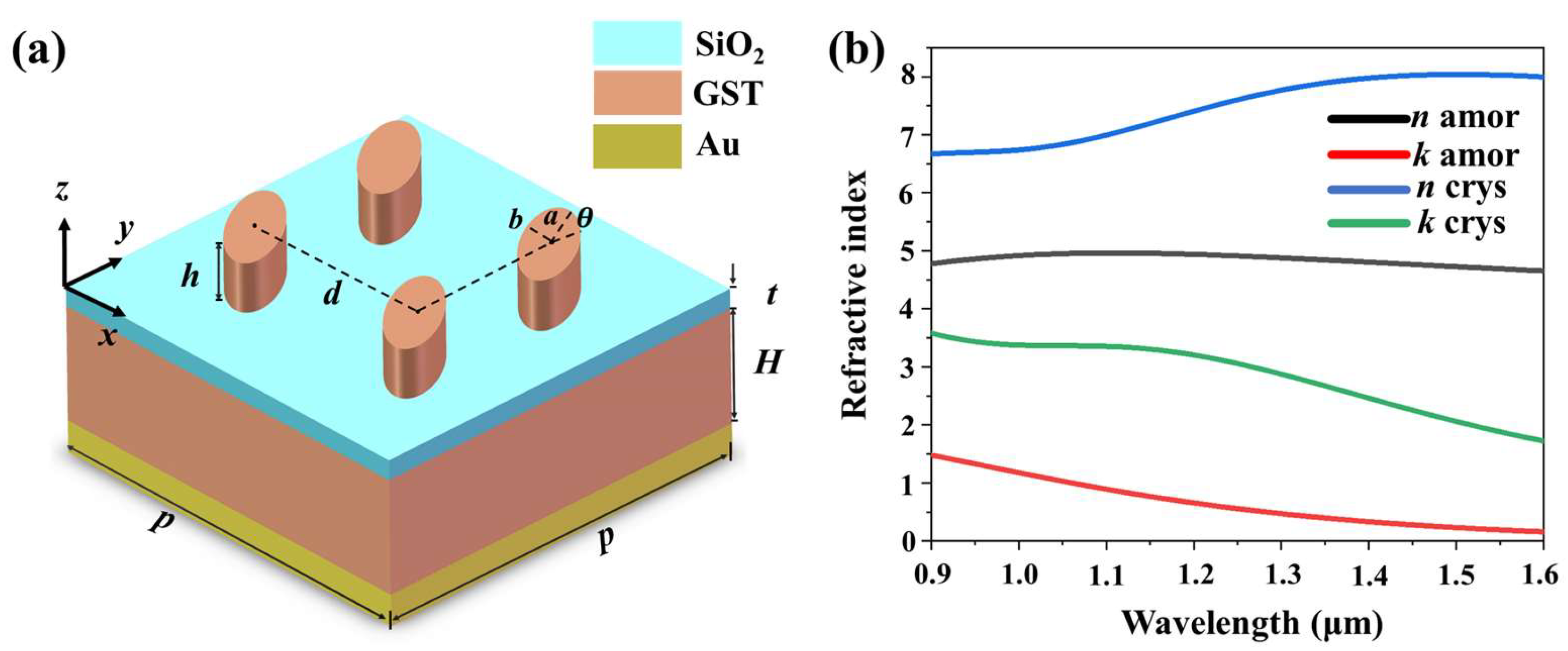
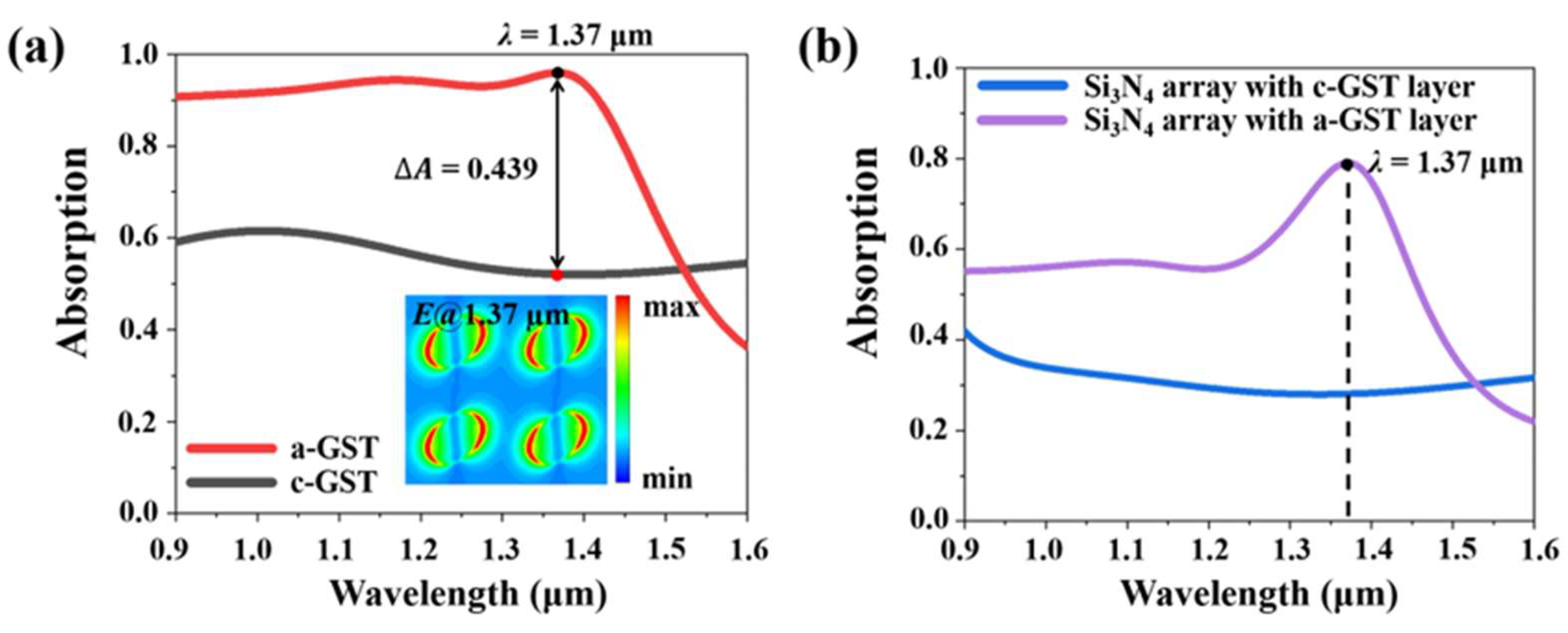
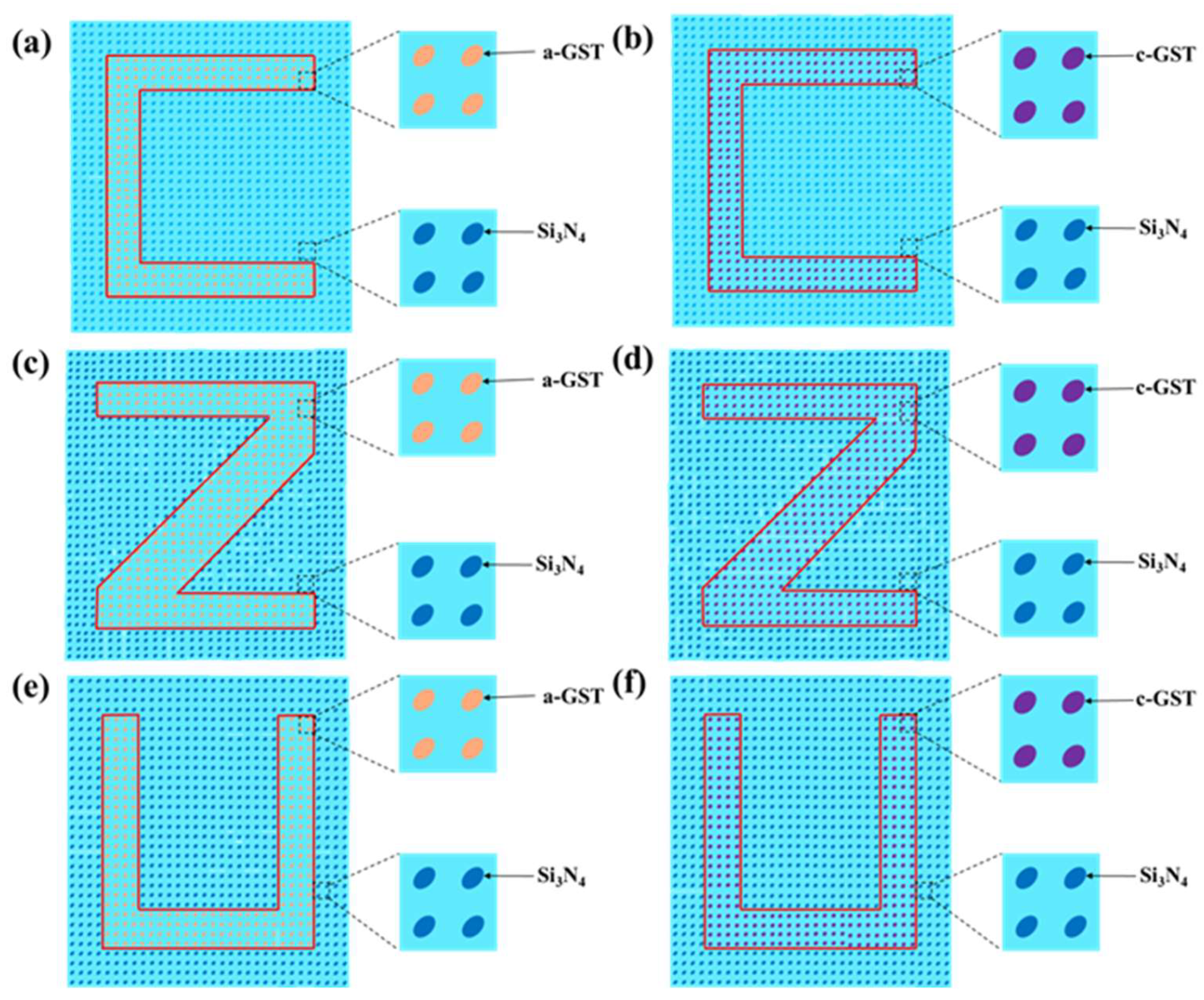
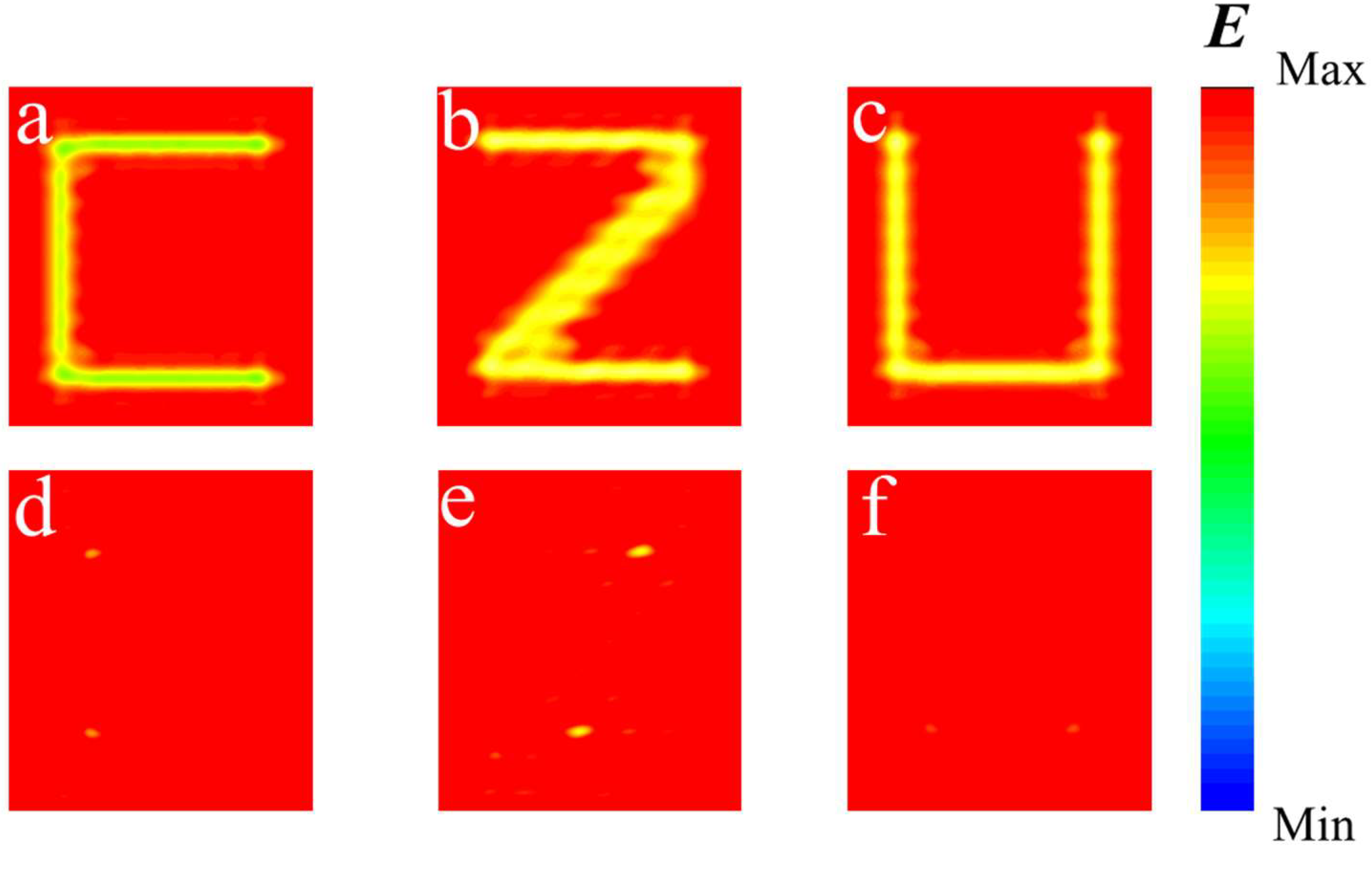

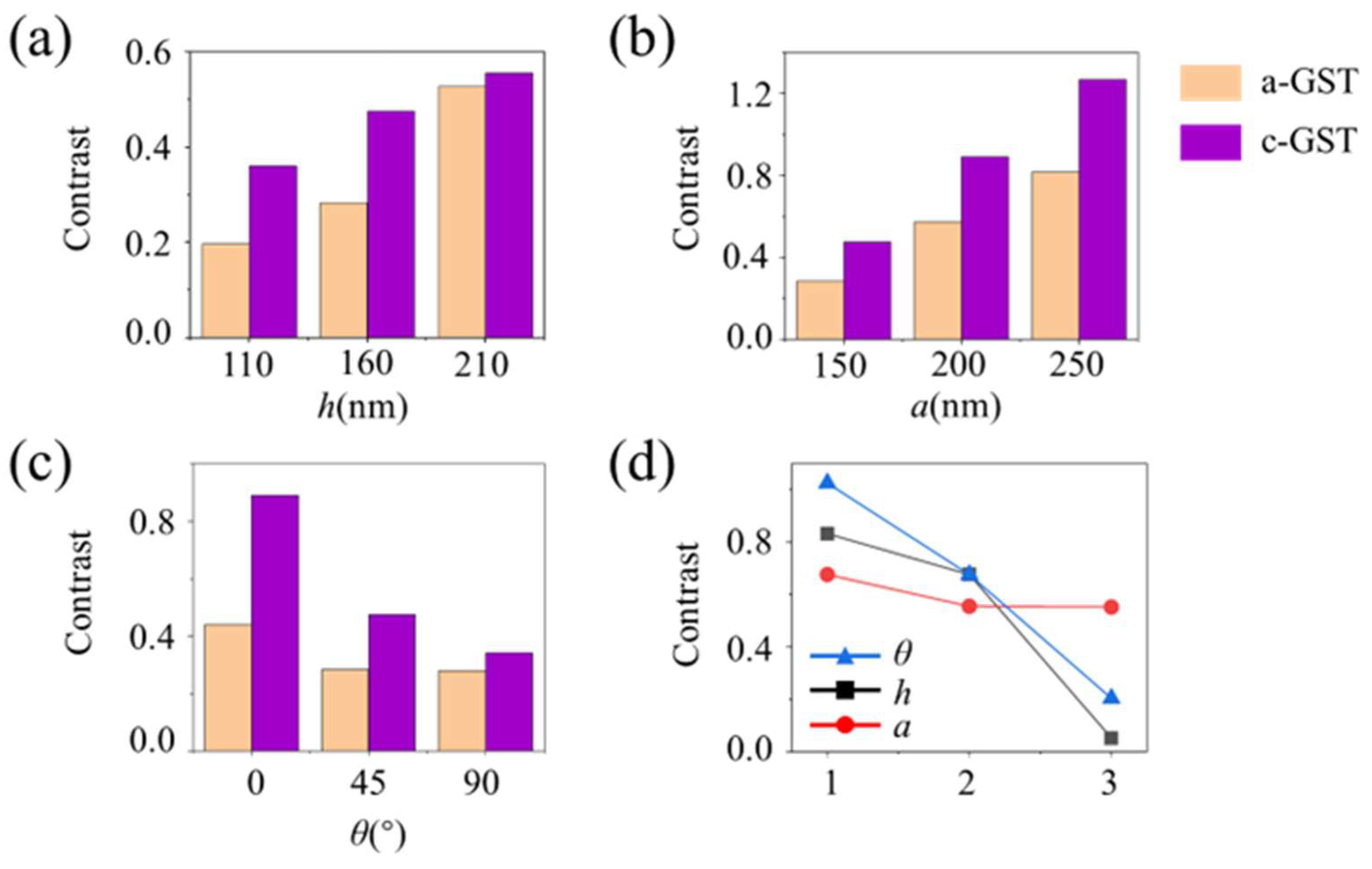
Disclaimer/Publisher’s Note: The statements, opinions and data contained in all publications are solely those of the individual author(s) and contributor(s) and not of MDPI and/or the editor(s). MDPI and/or the editor(s) disclaim responsibility for any injury to people or property resulting from any ideas, methods, instructions or products referred to in the content. |
© 2024 by the authors. Licensee MDPI, Basel, Switzerland. This article is an open access article distributed under the terms and conditions of the Creative Commons Attribution (CC BY) license (https://creativecommons.org/licenses/by/4.0/).
Share and Cite
Qiu, Z.; Jin, G.; Tang, B. Thermally Controlled Broadband Ge2Sb2Te5-Based Metamaterial Absorber for Imaging Applications. Photonics 2024, 11, 272. https://doi.org/10.3390/photonics11030272
Qiu Z, Jin G, Tang B. Thermally Controlled Broadband Ge2Sb2Te5-Based Metamaterial Absorber for Imaging Applications. Photonics. 2024; 11(3):272. https://doi.org/10.3390/photonics11030272
Chicago/Turabian StyleQiu, Zifeng, Gui Jin, and Bin Tang. 2024. "Thermally Controlled Broadband Ge2Sb2Te5-Based Metamaterial Absorber for Imaging Applications" Photonics 11, no. 3: 272. https://doi.org/10.3390/photonics11030272




